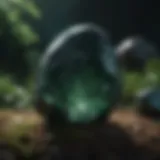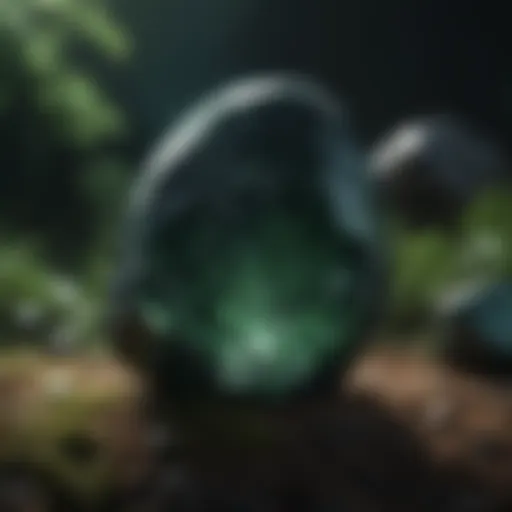Unraveling the Enigmatic World of Jurassic Claws: A Detailed Analysis
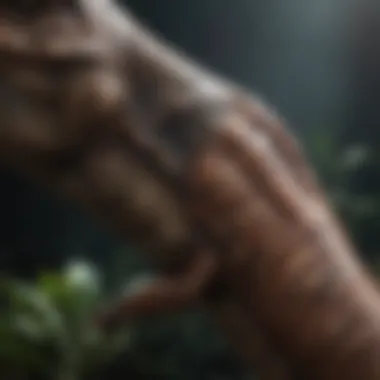

Rock and Fossil Identification
In the realm of Jurassic World claws, uncovering and identifying the rocks and fossils associated with these prehistoric creatures is a pivotal step in understanding their evolutionary journey. Types of rocks prevalent in Jurassic World deposits include sedimentary rocks such as limestone and sandstone that often hold fossilized remains. To identify these fossils effectively, collectors seek out key characteristics such as coloration, texture, and any visible imprints or markings that may indicate the presence of claws from ancient creatures. Utilizing tools like brushes, chisels, and magnifying glasses, enthusiasts meticulously examine the rocks to reveal the hidden treasures within.
Geological Insights
Delving into the geological factors surrounding Jurassic World claws provides valuable context to their discovery and significance. By studying the geological formations and processes that shaped the environments where these prehistoric creatures roamed, researchers can unveil how these creatures interacted with their surroundings. Analyzing the historical significance of specific rock formations and fossil-bearing strata offers profound insights into ancient ecosystems and the creatures that inhabited them. Notable discoveries made within these geological contexts have reshaped our understanding of the past, shedding light on the mysteries of Jurassic World claws and the creatures that wielded them.
Introduction
The allure of Jurassic World claws is a subject of utmost importance within the realm of paleontology and evolutionary biology. This article embarks on a journey to unravel the mysteries housed within these ancient marvels, shedding light on their evolutionary significance and adaptive prowess. By delving deep into the development and functional aspects of these claws, we aim to bring forth a comprehensive guide that will captivate rock and fossil collectors with intriguing insights and detailed analyses.
The Allure of Jurassic World Claws
Understanding the fascination with dinosaur claws
Dinosaur claws, with their sharp and imposing nature, have long captured the imagination of enthusiasts and researchers alike. The striking visual appeal coupled with the practical functions of these claws form the crux of their allure. Understanding the fascination with dinosaur claws is paramount as it unveils the evolutionary adaptations that influenced their development and shaped prehistoric ecosystems. This section dives into the roots of this fascination, exploring how these ancient appendages have left an indelible mark on paleontological studies.
Impact of claws on predator-prey dynamics
The impact of claws on predator-prey dynamics is a facet that underscores the intricate dance of power and survival in prehistoric landscapes. From the hunting strategies of fearsome predators to the defensive mechanisms of prey species, claws have played a pivotal role in shaping these dynamics. This section elucidates how the evolution of claws catalyzed behavioral changes among ancient creatures, influencing the hierarchy and interactions within Jurassic World. By unraveling the nuances of predator-prey relationships mediated by claws, we gain valuable insights into the ecological intricacies of bygone eras.
Significance in Paleontology
Clues to dinosaur behavior and ecology
The claws of dinosaurs serve as invaluable clues that offer glimpses into the behavior and ecology of these ancient beings. Through the study of claw morphology and usage patterns, researchers can piece together puzzles related to locomotion, feeding habits, and social interactions among dinosaurs. Delving into this aspect sheds light on the behavioral nuances of extinct species, allowing us to reconstruct their worlds with greater accuracy and detail. This section delves into the significance of these clues, showcasing how a closer examination of dinosaur claws can unlock hidden chapters of paleontological history.
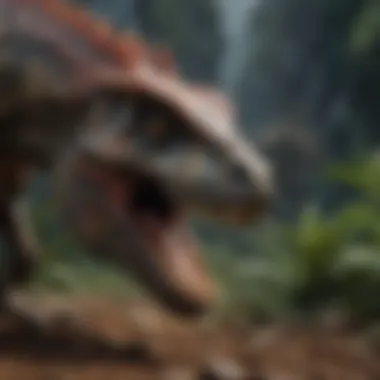

Implications for evolutionary studies
The implications of dinosaur claws for evolutionary studies extend far beyond their role as mere appendages. By analyzing the evolutionary trajectories of claw structures across different species, researchers can discern patterns and trends that offer profound insights into adaptation and survival strategies. This section explores how the study of dinosaur claws contributes to our understanding of evolutionary processes, highlighting the interconnectedness between form, function, and environmental pressures. By tracing the evolutionary pathways paved by these iconic appendages, we gain a deeper appreciation for the intricacies of life's perennial dance with change and adaptation.
Evolutionary Origins
In the labyrinthine realm of Jurassic World claws, the Evolutionary Origins stand as the foundational cornerstone, imbued with a wealth of insights and revelations that illuminate the path to understanding the enigmatic past. This section serves as a pivotal juncture in our exploration, unraveling the intricate tapestry of how these prehistoric marvels came to be, offering a glimpse into the evolutionary forces that shaped the very essence of these ancient predators. The Evolutionary Origins not only illuminate the origins of claw structures but also unveil the sophisticated adaptations that allowed dinosaurs to thrive in their primordial world. Through a meticulous dissection of evolutionary pathways and biological mechanisms, this segment delves into the deep recesses of time to unearth the evolutionary legacy etched within the relic of dinosaur claws, shedding light on the adaptive prowess and survival strategies honed through millennia of evolution.
Development of Claw Structures
Adaptations for Different Dinosaur Species
Within the intricate tapestry of dinosaur evolution, the Adaptations for different dinosaur species emerge as a captivating thread, intricately woven into the very fabric of ancient biodiversity. These adaptations showcase a diverse array of specialized features tailored to suit the specific ecological niches inhabited by various dinosaur taxa. From raptor claws designed for precision strikes to the massive slashing talons of theropods, each adaptation reflects a unique evolutionary trajectory honed through the crucible of natural selection. The Adaptations for different dinosaur species not only exemplify the evolutionary creativity at play but also underscore the intricate dance between form and function that sculpted the rich tapestry of dinosaur diversity. By unraveling the intricacies of these adaptations, we gain a profound appreciation for the exquisite balance between predator and prey, hunter and scavenger, each finely tuned to fulfill its ecological role within the ancient ecosystems.
Role of Claws in Locomotion and Feeding
The Role of claws in locomotion and feeding echoes like a primal heartbeat through the annals of evolutionary history, a testament to the multifaceted utility of these deceptively simple structures. Beyond their obvious function as weapons of predation, claws served as integral tools in the locomotor and feeding behaviors of dinosaurs, allowing for precise manipulation of objects and efficient traversal through rugged terrains. Whether used to grasp onto slippery prey or scale steep cliffs with deft agility, the role of claws in locomotion and feeding exemplifies the adaptive versatility ingrained within these ancient appendages. Exploring the intricate interplay between form and function, this subsection delves into the biomechanical intricacies that underpin the locomotor and feeding adaptations associated with dinosaur claws, shedding light on the evolutionary pressures that shaped these remarkable structures throughout geologic time.
Comparative Anatomy
Variations in Claw Shapes and Sizes
Within the nuanced landscape of claw morphology, Variations in claw shapes and sizes emerge as a testament to the evolutionary diversity etched within the fossil record. From the slender, curved talons of theropods to the robust, chunky claws of ankylosaurs, these variations in size and shape speak volumes about the ecological niches occupied by different dinosaur taxa. By delving into the intricate details of claw morphology, we unveil a trove of information regarding the evolutionary trajectories and ecological adaptations that sculpted these ancient predators into formidable hunters and defenders. The Variations in claw shapes and sizes not only exemplify the kaleidoscopic diversity of dinosaur claws but also offer profound insights into the selective pressures that drove the evolution of these enigmatic structures, shaping the course of prehistoric life with unparalleled precision and ingenuity.
Evolutionary Trends in Claw Morphology
The evolving saga of claw morphology unfolds like a grand symphony in the annals of paleontological history, tracing the intricate patterns of innovation and adaptation that defined the evolutionary trajectories of dinosaur claws. From the primitive, unadorned claws of early theropods to the hyper-specialized killing implements of advanced dromaeosaurs, evolutionary trends in claw morphology provide a window into the dynamic interplay between form and function across deep time. By dissecting the subtle nuances of claw evolution, we glean valuable insights into the adaptive strategies employed by diverse dinosaur lineages, unraveling the enigmatic puzzle of claw diversity and functionality embedded within the fossil record. The Evolutionary trends in claw morphology not only showcase the remarkable plasticity of evolutionary trajectories but also highlight the profound influence of ecological dynamics on the intricate dance of form and function that defined the evolutionary history of dinosaur claws.


Functional Aspects
Functional aspects play a vital role in unraveling the mysteries of Jurassic World claws by shedding light on the practical functions and survival strategies of these ancient marvels. Understanding the intricate details of how claws served as weapons and tools for survival provides essential insights into dinosaur behavior and ecology. These aspects not only showcase the adaptive advantages of sharp claws but also delve into the social interactions among dinosaurs that were influenced by these unique features.
Claws as Weapons
Strategies for Hunting and Defense
In the realm of Jurassic World claws, the strategies for hunting and defense were paramount in ensuring the survival and dominance of various dinosaur species. The specific aspect of strategies for hunting and defense unveils the tactical approaches adopted by dinosaurs to procure food and fend off predators. The key characteristic of these strategies lies in their versatility and efficiency in different hunting scenarios, making them a preferred choice for this article. The unique feature of these strategies is their adaptive nature, allowing dinosaurs to adapt their hunting techniques based on prey size and behavior, providing advantages in tackling diverse challenges.
Mechanisms of Claw-Inflicted Injuries
Examining the mechanisms of claw-inflicted injuries offers valuable insights into how claws were utilized as formidable weapons by dinosaurs. By understanding the key characteristic of these mechanisms, which is the precision and sharpness of dinosaur claws, we can grasp their devastating impact on prey and rivals. This unique feature underscores the efficiency and lethality of claw-inflicted injuries in the context of Jurassic World claws. It showcases both the advantages of ensuring successful hunting endeavors and the potential disadvantages of overreliance on claws, striking a balance between survival and sustainable resource utilization.
Tool for Survival
Adaptive Advantages of Sharp Claws
The adaptive advantages of sharp claws illuminate the evolutionary significance and practical benefits associated with this trait among dinosaurs. Highlighting the key characteristic of sharp claws, which is their dual functionality in both hunting and safeguarding, emphasizes their critical role in ensuring the survival and prosperity of dinosaur species. The unique feature of sharp claws lies in their versatility, enabling dinosaurs to exploit a wide range of ecological resources effectively. By exploring the advantages and disadvantages of sharp claws in Jurassic World, we gain a deeper understanding of their role as multifaceted tools for survival.
Claws in Social Interactions Among Dinosaurs
Uncovering the social interactions among dinosaurs mediated by their claws provides a fascinating glimpse into the dynamics of ancient ecosystems. The key characteristic of claws in social interactions lies in their communicative function, facilitating hierarchies and mate selection within dinosaur communities. This aspect signifies the beneficial role of claws in establishing social bonds and resolving conflicts among dinosaurs, contributing to the overall coherence of dinosaur societies. Understanding the unique feature of claws in social interactions enhances our comprehension of the intricate web of relationships and behaviors that shaped Jurassic World.
Implications for Modern Science
Biomechanical Studies
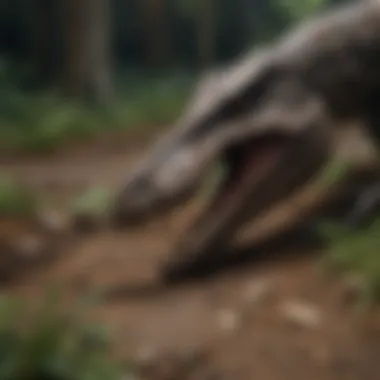

Biomechanical studies play a pivotal role in unraveling the mysteries associated with Jurassic World claws. These studies delve into the intricate mechanics behind the evolution and functioning of dinosaur claws, offering invaluable insights for modern scientific disciplines. By exploring how these claws interacted with their environment and prey, researchers can extrapolate essential data for various fields.
Applications of Claw Biomechanics in Robotics
The application of claw biomechanics in robotics bridges the ancient world with modern technology, shedding light on how the structure of dinosaur claws can inspire innovative robotic designs. Understanding the mechanics of dinosaur claw movements aids in the development of more efficient robotic appendages, enhancing grasping and manipulation capabilities. This application not only showcases the adaptability of ancient adaptations but also opens avenues for interdisciplinary research, fostering a deeper comprehension of biomechanics in both biological and artificial systems.
Insights for Modern Engineering Designs
Insights derived from studying dinosaur claw biomechanics offer a goldmine of information for modern engineering designs. By honing in on the structural efficiency and functionality of dinosaur claws, engineers can glean inspiration for creating cutting-edge tools and devices. The unique features of dinosaur claw structures, such as their curvature and serration patterns, provide crucial benchmarks for engineering designs, optimizing performance and adaptability in various applications. Leveraging these insights paves the way for groundbreaking advancements in fields ranging from robotics to materials science.
Behavioral Ecology
Behavioral ecology stands at the forefront of deciphering the nuanced relationships between dinosaurs and their environments, shedding light on the behavioral implications of their claw adaptations. By scrutinizing the behavioral patterns associated with claw use in extant species, researchers can draw parallels to ancient counterparts, uncovering evolutionary strategies and social dynamics among dinosaurs.
Interpreting Claw-Related Behaviors in Extant Species
An essential aspect of behavioral ecology is interpreting claw-related behaviors in extant species to discern overarching themes in evolutionary strategies and intra-species interactions. By studying how modern animals utilize their claws for hunting, defense, and communication, researchers can infer ancestral behaviors exhibited by dinosaurs. This comparative approach facilitates a deeper understanding of the adaptive advantages and constraints associated with claw functionalities, shedding light on the evolutionary significance of such adaptations.
Comparative Studies on Claw Function Across Taxa
Conducting comparative studies on claw function across taxa offers a comprehensive lens into the varied evolutionary paths taken by different species in optimizing claw structures. By juxtaposing the claw adaptations across diverse groups, researchers can pinpoint evolutionary trends and ecological influences that shaped claw morphology. This comparative analysis not only highlights the adaptational flexibility of claws but also underscores the intricate interplay between anatomy, behavior, and environmental pressures. Such investigations illuminate the diverse evolutionary trajectories of clawed organisms and provide a deeper appreciation for the overarching principles governing biological adaptations.
Conclusion
In the grand mosaic of uncovering the mysteries entwined within the Jurassic World's majestic claws, the conclusion serves as the capstone, consolidating the intricate revelations amassed throughout this expository journey. As the culminating segment, the conclusion encapsulates the essence of the entire exploration, emphasizing the core tenets that underpin the significance of discerning the enigmatic tales hidden within the claws of ancient behemoths. Delving into the concluding section unravels a tapestry woven with the integral threads of past wonders and future possibilities, bridging prehistory with contemporary pursuits of knowledge and understanding. The conclusion not only serves as the amalgamation of researched insights but also propels us towards envisioning the evolutionary trajectories and biotechnological frontiers that the study of these claws unveils.
Unveiling the Legacy of Jurassic World Claws
Reflecting on the enduring mysteries of dinosaur claws
Reflecting on the enduring mysteries bound within the enigmatic core of dinosaur claws unearths a profound testament to the timeless intrigue that these primal appendages bestow upon the realm of paleontology. The enduring aura of mystery serves as a hallmark, guiding enthusiasts and scholars alike towards a deeper contemplation of the complexities veiled in ancient structures that transcend epochs ergo into the present. Its allure lies not only in the tactile details etched upon fossilized remnants but also in the metaphysical allure of unlocking nature's coded secrets sheltered beneath prehistory's veil. The evocative power of reflecting on these enduring mysteries resonates deeply within the reverberations of scientific inquiry, prompting thoughtful musings and illuminating pathways for further exploration into the depths of history's footprint.
Implications for future paleontological research
Within the intricate tapestry of paleontological pursuits, the implications stemming from unraveling the enigmas tucked within Jurassic World claws usher forth a new dawn of scholarly investigations and epochal dawnings. The precipice upon which future paleontological research stands precariously intersects with the elaborations exuding from the implications sprung forth by the mysteries housed within ancient talons. As the sands of time flow incessantly, these implications cast a sprawling net of potentialities, illuminating avenues for innovative methodologies, technological applications, and philosophical insights. The nuanced interplay between the trace remnants of the past and the anticipatory flickers of modern inquiry paints a canvas ripe with anticipations swathed in the poignant reverence for scientific progress and enlightened conjectures propelling forth the wielded touch
